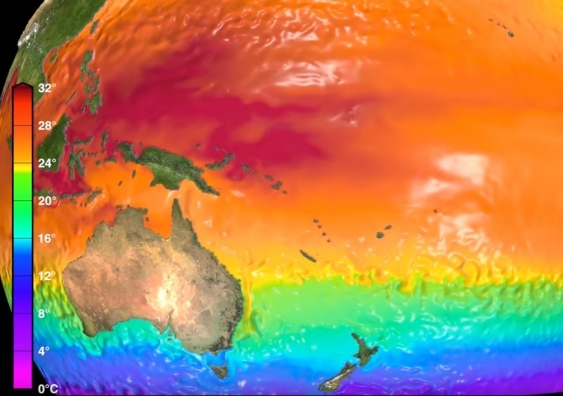Australian researchers from the National Computational Infrastructure (NCI) and the ARC Centre of Excellence for Climate System Science, based at UNSW, have produced a remarkable high-resolution animation of the largest El Niño ever recorded.
It is so detailed that it took 30,000 computer hours crunching ocean model data on Australia’s most powerful supercomputer, Raijin, before it could be extracted by the NCI visualisation team to produce.
The animation looks beneath the ocean surface to reveal the oceanic processes that led to the 1997/98 El Niño – an event that caused billions of dollars of damage worldwide and was followed by consecutive strong La Niña events.
This animation looks beneath the ocean surface to reveal the oceanic processes that led to the 1997/98 El Niño, an event that caused billions of dollars of damage worldwide and was followed by consecutive strong La Niña events.
“The animation shows how shifting pools of warmer or cooler than average water 300m below the surface of the ocean can trigger these powerful events,” said UNSW's Dr Alex Sen Gupta, a member of the visualisation team from the ARC Centre of Excellence for Climate System Science.
“When these pools of water burst through to the surface and link up with the atmosphere they can set off a chain reaction that leads to El Niños or La Niñas,” Dr Sen Gupta said.
The animation shows us that a well developed deep ocean observation system can give us advance warning of extreme El Niños and La Niñas.
The ocean model that produced the animation used a 30km horizontal grid and split the vertical depth into 50 cells, which allowed the researchers to see the development of the El Niño and La Niñas at a high resolution.
“Raijin gives us the capacity to model complex global systems like El Niño that require a high resolution for a better accuracy,” said Associate Professor Andy Hogg, a member of the team from the Australian National University.
“It was these huge volumes of data produced by the model that meant we needed the specialist visualisation expertise from NCI to reveal what happened in detail.”
The 97/98 El Niño was a particularly damaging event. It was linked to massive forest fires in Indonesia, catastrophic flooding in Peru and the first “global” coral bleaching event that killed 16% of the world’s corals in a single year.
While it is impossible to prevent such events, researchers believe and the model confirms that better observation systems can help us forecast them earlier.
“The animation shows us that a well developed deep ocean observation system can give us advance warning of extreme El Niños and La Niñas,” said team member Dr Shayne McGregor from Monash University.
“Preserving and expanding the currently sparse observation system is critical to improving our seasonal prediction capability in the future.”
Research over the past few years led by CSIRO and UNSW has indicated that “super” El Niños like the 97/98 event are likely to become more frequent as the climate warms.
A member of the visualisation team from UNSW, Dr Agus Santoso found in 2013 that as the climate warms, we are likely to see noticeable changes to El Niños.
“As the planet warms it also appears that the swings between the two extremes, from El Niño to La Niña like the 1997 to 1999 sequence, will become more frequent,” said Dr Santoso.
“For this reason and many others a reliable early warning of El Niño and La Niña will be vital for farmers, industry groups and societies to be better prepared for the extreme conditions they inevitably bring.”


